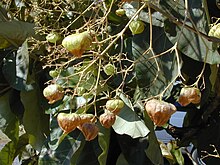Tectona grandis
| Teak | |
|---|---|
 |
|
| Teak foliage and fruits | |
| Scientific classification | |
| Kingdom: | Plantae |
| (unranked): | Angiosperms |
| (unranked): | Eudicots |
| (unranked): | Asterids |
| Order: | Lamiales |
| Family: | Lamiaceae |
| Genus: | Tectona |
| Species: | T. grandis |
| Binomial name | |
|
Tectona grandis L.f. |
|
| Synonyms | |
|
|
Teak (Tectona grandis) is a tropical hardwood tree species placed in the flowering plant family Lamiaceae. Tectona grandis is a large, deciduous tree that occurs in mixed hardwood forests. It has small, fragrant white flowers and large papery leaves that are often hairy on the lower surface. It is sometimes known as the "Burmese teak". Teak wood has a leather-like smell when it is freshly milled. It is particularly valued for its durability and water resistance, and is used for boat building, exterior construction, veneer, furniture, carving, turnings, and other small wood projects.Tectona grandis is native to south and southeast Asia, mainly India, Sri Lanka, Indonesia, Malaysia, Thailand, Myanmar and Bangladesh but is naturalised and cultivated in many countries in Africa and the Caribbean. Myanmar's teak forests account for nearly half of the world's naturally occurring teak. Molecular studies show that there are two centres of genetic origin of teak; one in India and the other in Myanmar and Laos. "CP teak" ("Central Province" teak) is a description of teak from the central states of India. "Nagpur teak" is another regional Indian teak. It produces small, white flowers arranged in dense clusters (panicles) at the end of the branches. Flowers contain both types of reproductive organs (perfect flowers)
The word teak comes from, Tamil "tekku" (தேக்கு), Malayalam word thekku, (തേക്കു്) via the Portuguese teca. The plant is known as Thekka (තේක්ක) in Sinhala by Sri Lankan people.
...
Wikipedia
